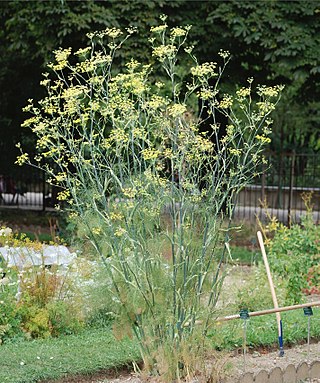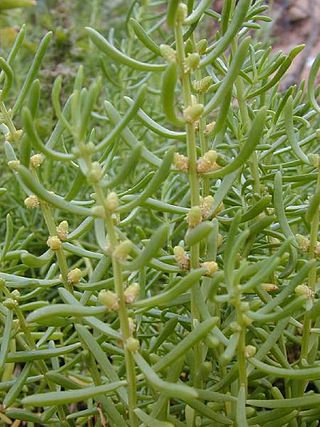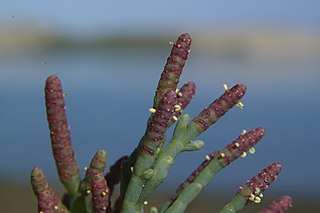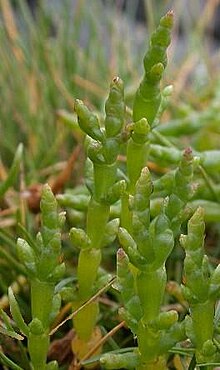
Fennel is a flowering plant species in the carrot family. It is a hardy, perennial herb with yellow flowers and feathery leaves. It is indigenous to the shores of the Mediterranean but has become widely naturalized in many parts of the world, especially on dry soils near the sea coast and on riverbanks.

The White Cliffs of Dover are the region of English coastline facing the Strait of Dover and France. The cliff face, which reaches a height of 350 feet (110 m), owes its striking appearance to its composition of chalk accented by streaks of black flint, deposited during the Late Cretaceous. The cliffs, on both sides of the town of Dover in Kent, stretch for eight miles (13 km). The White Cliffs of Dover form part of the North Downs. A section of coastline encompassing the cliffs was purchased by the National Trust in 2016.

Crithmum is a monospecific genus of flowering plant in the carrot family Apiaceae, with the sole species Crithmum maritimum, known as rock samphire, sea fennel or samphire. The name "samphire" is also used for several other unrelated succulent halophyte species of coastal plant.

Salicornia is a genus of succulent, halophytic flowering plants in the family Amaranthaceae that grow in salt marshes, on beaches, and among mangroves. Salicornia species are native to North America, Europe, central Asia, and southern Africa. Common names for the genus include glasswort, pickleweed, picklegrass, and marsh samphire; these common names are also used for some species not in Salicornia. To French speakers in Atlantic Canada, they are known colloquially as titines de souris. The main European species is often eaten, called marsh samphire in Britain, and the main North American species is occasionally sold in grocery stores or appears on restaurant menus as sea beans, samphire greens or sea asparagus.

Batis is a genus of two species of flowering plants, the only genus in the family Bataceae. They are halophytic plants, native to the coastal salt marshes of warm temperate and tropical America and tropical Australasia.

Chayote or Sicyos edule, also known as christophine, mirliton and choko, is an edible plant belonging to the gourd family, Cucurbitaceae. This fruit was first cultivated in Mesoamerica between southern Mexico and Honduras, with the most genetic diversity available in both Mexico and Guatemala. It is one of several foods introduced to the Old World during the Columbian Exchange. At that time, the plant spread to other parts of the Americas, ultimately causing it to be integrated into the cuisine of many Latin American nations.

The Salicornioideae are a subfamily of the flowering plant family Amaranthaceae. Important characters are succulent, often articulated stems, strongly reduced leaves, and flowers aggregated in thick, dense spike-shaped thyrses. These halophytic plants are distributed worldwide. Many are edible

Leaf vegetables, also called leafy greens, pot herbs, vegetable greens, or simply greens, are plant leaves eaten as a vegetable, sometimes accompanied by tender petioles and shoots. Leaf vegetables eaten raw in a salad can be called salad greens.

The glassworts are various succulent, annual halophytic plants, that is, plants that thrive in saline environments, such as seacoasts and salt marshes. The original English glasswort plants belong to the genus Salicornia, but today the glassworts include halophyte plants from several genera, some of which are native to continents unknown to the medieval English, and growing in ecosystems, such as mangrove swamps, never envisioned when the term glasswort was coined.

Rocket, eruca, or arugula is an edible annual plant in the family Brassicaceae used as a leaf vegetable for its fresh, tart, bitter, and peppery flavor. Its other common names include garden rocket, as well as colewort, roquette, ruchetta, rucola, rucoli, and rugula.
Samphire is a name given to several unrelated, edible plants that grow in coastal areas.

Samphire Hoe is a country park situated 2 miles (3 km) west of Dover in Kent in southeast England. The park was created by using 4.9 million cubic metres of chalk marl from the Channel Tunnel excavations and is found at the bottom of a section of the White Cliffs of Dover. The site is owned by Getlink, and managed by the White Cliffs Countryside Project.

Salicornia quinqueflora, synonym Sarcocornia quinqueflora, commonly known as beaded samphire, bead weed, beaded glasswort or glasswort, is a species of succulent halophytic coastal shrub. It occurs in wetter coastal areas of Australia and New Zealand.

Tecticornia arbuscula, the shrubby glasswort or scrubby samphire, is a species of plant in the family Amaranthaceae, native to Australia. It is a shrub that grows to 2 metres in height, with a spreading habit. It has succulent swollen branchlets with small leaf lobes.

Caulerpa lentillifera or sea grape is a species of ulvophyte green algae from coastal regions in the Asia-Pacific. This seaweed is one of the favored species of edible Caulerpa due to its soft and succulent texture. It is traditionally eaten in the cuisines of Southeast Asia, Oceania, and East Asia. It was first commercially cultivated in the Philippines in the 1950s, followed by Japan in 1968. Both countries remain the top consumers of C. lentillifera. Its cultivation has since spread to other countries, including Vietnam, Taiwan, and China. C. lentillifera, along with C. racemosa, are also known as sea grapes or green caviar in English.

Circeo National Park is an Italian national park founded in 1934. It occupies a strip of coastal land from Anzio to Terracina, including also a sector of forest in the mainland of San Felice Circeo, and the island of Zannone.

Suaeda maritima is a species of flowering plant in the family Amaranthaceae known by the common names herbaceous seepweed and annual seablite.

Salicornia europaea, known as marsh samphire, common glasswort or just glasswort, is a halophytic annual dicot flowering plant in the family Amaranthaceae. Glasswort is a succulent herb also known as "pickle weed" or "marsh samphire". As a succulent, it has high water content, which accounts for its slightly translucent look and gives it the descriptive name "glasswort". To some people, it is known as "chicken toe" because of its shape. To others, it is called "saltwort". It grows in various zones of intertidal salt marshes, on beaches, and among mangroves.
Fennel is a species of plant, Foeniculum vulgare

Salicornia pacifica, also known as pickleweed, sea asparagus, Pacific swampfire, or glasswort, is a species of low-growing perennial succulent halophyte in the genus Salicornia found in the Pacific coast of North America and California.

















